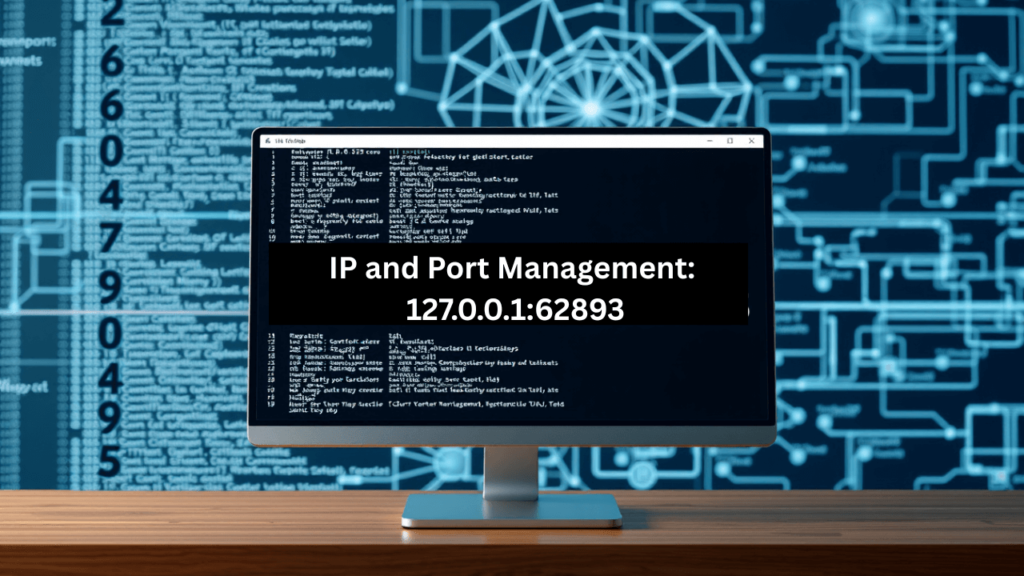If you have ever opened your local development server or worked with a software tool and stumbled across something like 127.0.0.1:62893, you are not alone. It pops up often during debugging, testing, or even casual use of web applications—but what does it actually mean? And more importantly, do you need to care?
For many, the string IP and Port Management: 127.0.0.1:62893 looks like cryptic tech jargon. But if you deal with networks, web development, or cybersecurity, understanding it can make your life a lot easier.
Let us break it down—clearly, simply, and with real-world insights.
What Is 127.0.0.1:62893?
Before we dive into management practices, we need to understand what the components mean:
- 127.0.0.1 is the loopback IP address, also known as localhost. It refers to your own device.
- 62893 is a port number—a virtual gate that allows specific services or applications to communicate over your device’s network.
So, IP and Port Management: 127.0.0.1:62893 is essentially about managing how local services communicate through this specific IP and port combination.
Why Should You Care About IP and Port Management: 127.0.0.1:62893?
Let us put it into perspective. Imagine you are running a development server or testing an app on your machine. The server starts and listens on 127.0.0.1:62893. That port becomes your access point to interact with your project.
If you mismanage these configurations, you might:
- Struggle with accessing your app
- Encounter port conflicts
- Fail to connect client-side features
- Open potential security holes in production environments
Knowing how to manage this properly gives you more control, less frustration, and stronger security.

Key Benefits of Managing 127.0.0.1:62893 Properly
- Smoother Development Workflow
When you manage your IP and port configuration effectively, your development environment becomes more predictable and less prone to crashes. This ensures your local applications run smoothly without needing constant port changes. - Improved Troubleshooting
Knowing which port your service is running on, like 62893, makes it much easier to trace issues, detect conflicts, and resolve them without guesswork. It simplifies debugging and saves valuable development time. - Better Security
Although 127.0.0.1 is local, proper port management ensures that nothing unintended is exposed or accessed maliciously. Controlled ports reduce the risk of vulnerabilities, even during local testing phases. - Avoiding Port Conflicts
Managing ports prevents your system from assigning the same port to multiple services, which often leads to crashes or refusal to launch. This practice keeps development smooth, especially when working with microservices.
Disadvantages of Poor IP and Port Management
- Unexpected Service Failures
If multiple services try to use the same port like 62893, it can result in applications failing to start or abruptly shutting down. These failures can delay delivery timelines and create unnecessary frustration. - Security Vulnerabilities
Misconfigured or open ports may expose local tools to potential external threats, especially if mistakenly bound to a public IP. Even local testing ports should be monitored to prevent unauthorized access. - Complexity for Teams
Without a clear record of which service runs on what port, team members might overwrite configurations or face environment-specific issues. This leads to miscommunication and inconsistent development experiences. - Performance Overhead
Some background services might continuously occupy high-numbered ports like 62893 without your knowledge. This can slowly consume system resources and reduce overall application responsiveness.
What I Would Do Differently Now
If I were starting over as a web developer, I would make IP and Port Management: 127.0.0.1:62893 a priority from day one. Here is what I’d change:
- Use configuration files to control port selection dynamically
- Install port checking tools to detect and fix conflicts early
- Document every port assignment for every service during development
- Set firewall rules even for localhost to practice good security hygiene
How to Check What Is Running on 127.0.0.1:62893
You can use simple commands depending on your operating system:
- Windows
Runnetstat -a -n -o | findstr 62893in Command Prompt. - macOS/Linux
Trylsof -i :62893ornetstat -anp | grep 62893.
These commands help you detect whether the port is active and which process is using it.
Best Practices for Managing IP and Port Combos
- Stick to a Defined Port Range
Use a specific set of ports for development vs. production environments to avoid unnecessary conflicts and confusion. - Automate Port Selection
Use tools or frameworks that automatically assign available ports during development to save time and reduce errors. - Always Monitor Logs
Server logs often contain information about port usage, which helps in detecting unexpected behavior early. - Use Firewalls Smartly
Even though 127.0.0.1 is local, firewall rules can help ensure that only trusted applications use certain ports. - Use Environment Variables
Define ports via environment settings so they can be easily changed without modifying source code.
Common Misconceptions
- “127.0.0.1 is always safe.”
True—but only if all your services are properly secured and no ports are inadvertently exposed. - “Any port number works fine.”
Incorrect. Some ports are reserved or conflict with system processes. Always check availability. - “Port management is only for DevOps.”
Not true. Every developer, especially those working locally, should understand basic IP and port usage.
Frequently Asked Questions
Q1: What exactly is 127.0.0.1:62893 used for?
It is a loopback IP with a specific port, often used by development tools and servers to host local applications temporarily.
Q2: Can I change the port number?
Yes. Most tools and frameworks allow you to define a custom port either through configuration files or terminal commands.
Q3: Is port 62893 safe to use?
Yes, as long as it’s being used locally and is not publicly exposed. Always monitor usage to prevent conflicts.
Q4: What happens if the port is already in use?
Your application may fail to start or throw a binding error. You can stop the conflicting process or switch to another port.
Q5: Should I expose this port publicly?
Generally, no. Ports like 62893 running on 127.0.0.1 are meant for local-only access. Exposing them adds unnecessary risk.
Final Thoughts
In the digital world where services run on dozens of ports and IP addresses, ignoring IP and Port Management: 127.0.0.1:62893 is like ignoring the keys to your own house. It may seem minor at first, but when problems arise, understanding this concept can save time, reduce frustration, and improve your app’s performance and security.
If you’re in tech—developer, tester, or even a student—get comfortable managing ports and IPs. The clarity and control you gain are well worth the effort.
For more insights on managing network tools efficiently, check out our detailed guide on Proxiyum and how it enhances secure local connections.


